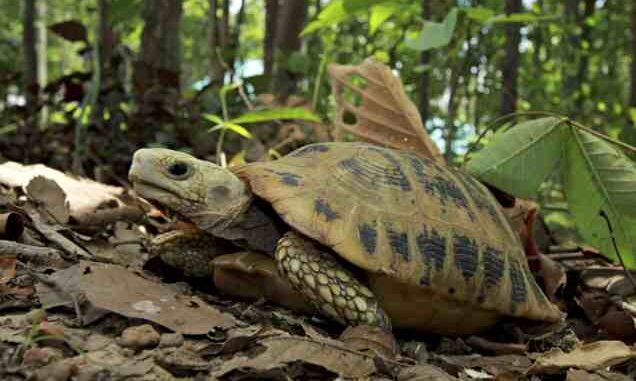
In News
The sal-forest tortoise is recently assessed as a critically endangered species.
In-Detail
- The sal-forest tortoise species found in India come under the threatened category in the IUCN red list.
- According to the IUCN, the population had fallen by 80% in the last three generations and is now a critically endangered species.
- Due to human activities, there is a severe existential threat to the species.
- The tortoise is collected for food, for making decorative masks and in international wildlife trade.
- Ecologistsfrom the Wildlife Institute of India, Dehradun, found that the area designated as a protected area network is only a small habitat of the species.
- Over 90% of the habitat distribution of the species falls outside the protected area.
- The study also shows that 29% of the distribution of the species falls within the high occurrence of fire zone areas. This includes the Uttarakhand state, which is the western distribution of the species.
- Northeast India is a suitable place for the species, but they experience Jhum fire.
- Forest fires may impact forest floor thus changing the community on which the reptiles depend.
Effort of Monitoring
- The WII ecologists say that the tortoise should be part of a regular monitoring effort.
- During summers, the tortoises select moist patches such as dry stream beds. Such moist patch areas should be protected from forest fires, they suggest.
- Experts also suggest that developing Conservation Units and transboundary conservation reserves such as Manas for the Indo-Bhutan region and the Sundarbans for the India-Bangladesh region will help protect the species.
About Sal-Forest Tortoise
- The sal-forest tortoise is also known asan elongated tortoise (Indotestudo elongate) and as a yellow tortoise in many parts of Asia.
- The sal-forest tortoise is found in Nepal, Bangladesh, India, Myanmar, Laos, Thailand, Cambodia, Vietnam, western Malaysia, and southern China.
- The sal-forest tortoise is widely found in the eastern and northern parts of India.
- They are small (12 to 14 inches long) and hardy, long-lived.
IUCN
- The International Union for Conservation of Nature (IUCN) is composed of both government and civil society organizations. It is established in the year 1964.
- India is a member of IUCN from the year 1969. The Indian country office was established in the year 2007 in New Delhi.
- The IUCN India aims to reduce ecosystem and species loss by facilitating tools and knowledge to value, conserve, and use biodiversity sustainability.
- According to IUCN, 132 species of plants and animals are listed as endangered species in India.

Leave a Reply
You must be logged in to post a comment.